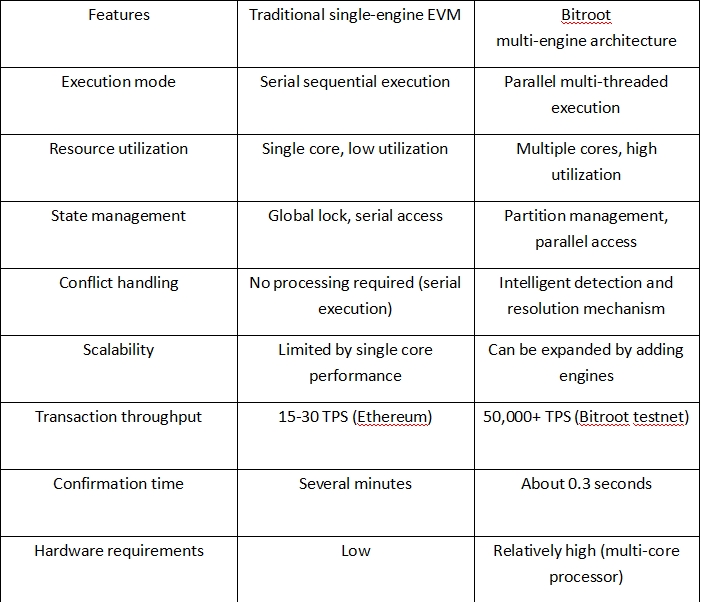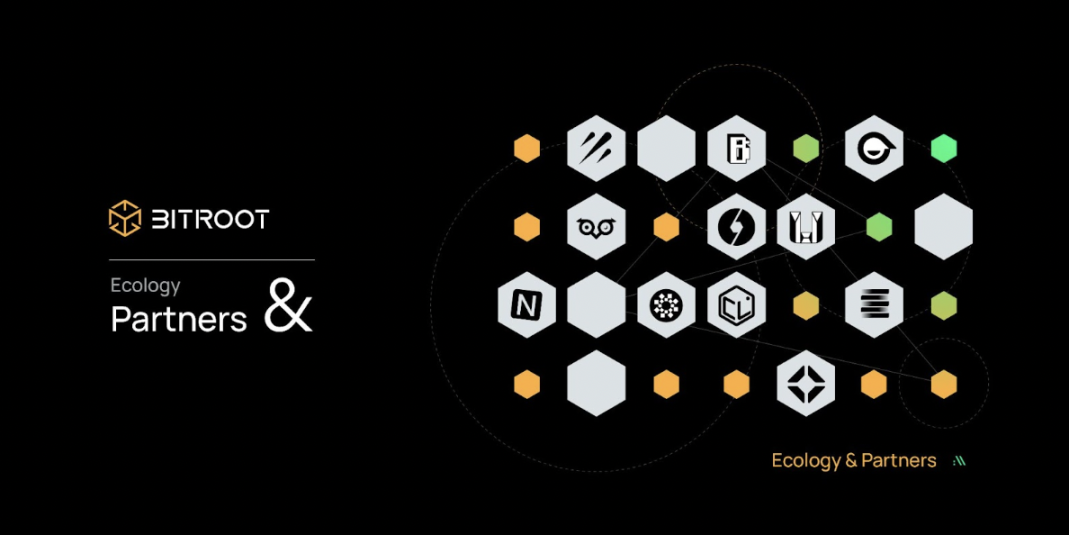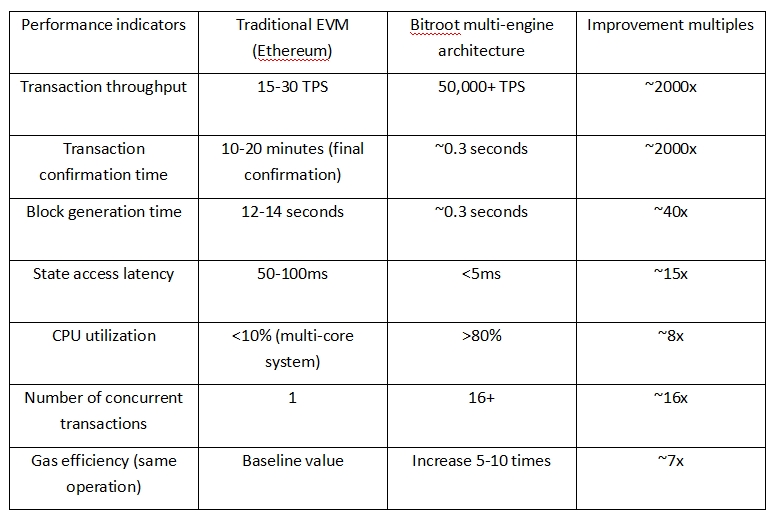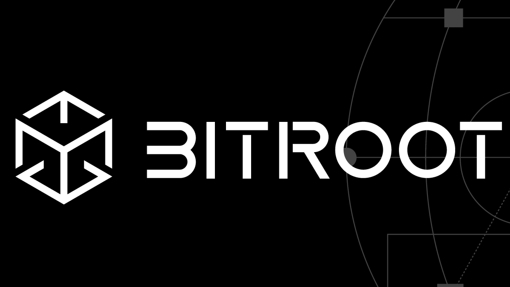Bitroot's parallel architecture represents a major breakthrough in blockchain execution layer technology. Through innovative multi-engine parallel design, it has successfully achieved a processing capacity of up to 100,000 TPS and a confirmation time of 0.3 seconds. This article will deeply analyze how Bitroot breaks through the traditional EVM performance bottleneck through parallel execution architecture and provides unprecedented performance support for blockchain applications. The traditional EVM architecture adopts a single-threaded sequential execution mode. Even if there is no dependency between transactions, they must be processed one by one, which severely limits the processing capacity and response speed of the blockchain. According to the research of the Monad project, the traditional EVM-based sequential execution mode of the blockchain execution layer fails to fully utilize the computing power of modern multi-core processors, forming a key technical bottleneck.
As an innovative blockchain solution, Bitroot has completely changed this situation by introducing a parallel execution engine. From the search results, Bitroot has been built around the concept of "high performance + high concurrency" since its initial design. Its technical architecture integrates a parallel transaction engine, an improved Pipeline BFT consensus mechanism, and an optimized Gas fee model. This design enables Bitroot to schedule multiple threads to process transactions in parallel at the same time, supporting high concurrency operations from the protocol level. The importance of multi-engine parallel design is self-evident. Similar parallel processing technologies have proven their powerful performance improvement capabilities in projects such as Aptos. Through 32 threads of parallel processing, Aptos has achieved a throughput of more than 160,000 TPS in actual tests. Bitroot's test network has demonstrated impressive performance data in just two weeks: the number of test network addresses exceeds 50,000, the average daily on-chain transaction volume exceeds 10,000, the measured peak TPS reaches 50,000+, and the average block time is only about 0.3 seconds. These data fully demonstrate the great value of multi-engine parallel execution design to blockchain performance improvement.

Review of traditional EVM architecture Design principles of Ethereum virtual machine As the most widely used smart contract execution environment in the blockchain world, Ethereum Virtual Machine (EVM) provides a strong computing foundation for decentralized applications. EVM is a stack-based virtual machine designed for executing Ethereum smart contracts. It adopts a single-threaded execution model and processes transactions in the entire block in strict sequence.
The EVM execution process can be roughly divided into the following steps:
-
Verify transaction signature and format
-
Parse transaction parameters and call data
-
Check relevant account status and balance
-
Execute smart contract code
-
Update status and generate event log
-
Update account nonce and balance Limitations of single-engine sequential execution
The single-engine sequential execution mode of traditional EVM has several major limitations: First, even if the transaction touches irrelevant parts of the state, it must be executed in sequence, which leads to underutilization of multi-core processor resources. Today's computers generally adopt multi-core architecture, and single-threaded execution cannot fully utilize the hardware potential.
Second, as the complexity of transactions increases, the execution time of each transaction becomes unpredictable, which may lead to extended block generation time and affect the throughput of the entire network. Traditional architecture is particularly evident when dealing with complex smart contracts.
Third, state management and access are inefficient. The traditional EVM state access mechanism generates a lot of overhead during frequent read and write operations, and the single-threaded execution mode cannot optimize these operations in parallel.
Transaction throughput and confirmation time bottlenecks
In actual applications, the traditional EVM architecture faces severe performance challenges:
-
Limited transaction throughput: The TPS (transactions per second) of the Ethereum main network is maintained between 15-30, which is far from meeting the needs of large-scale applications.
-
Long confirmation time: Ethereum transaction confirmation usually takes several minutes or even longer, which is not suitable for application scenarios that require fast response.
-
High Gas fees: During periods of network congestion, due to limited processing capacity, users need to pay high Gas fees to obtain priority processing rights.
Web3 applications require high-performance execution environments With the rapid development of the Web3 ecosystem, application scenarios have increasingly higher requirements for blockchain performance:
-
DeFi (decentralized finance): high-frequency transactions, flash loans, liquidity mining and other scenarios require extremely low transaction confirmation time and high throughput.
-
GameFi (game finance): Blockchain games require near-real-time transaction confirmation to provide a smooth gaming experience.
-
NFT market: The sale of popular NFTs often causes network congestion, requiring higher concurrent processing capabilities.
-
Web3 social applications: User interaction and content creation require fast responses, and traditional architectures are difficult to support large-scale users online at the same time.
-
AI and blockchain integration: In the future, the combination of AI applications and blockchain will require stronger computing support. These challenges and demands have jointly promoted the innovation of the blockchain execution layer architecture. Bitroot's multi-engine parallel execution design is designed to solve these problems.
Core design of multi-engine architecture Bitroot multi-engine architecture design principle Bitroot's multi-engine parallel architecture represents a major innovation in the blockchain execution layer. Through a carefully designed parallel processing mechanism, it effectively solves the performance bottleneck faced by traditional EVM.
Bitroot is designed from the bottom up around "high performance + high concurrency". Its multi-engine architecture is based on the following core principles:
-
Parallel transaction processing: Unlike the single-threaded execution of traditional EVM, Bitroot supports scheduling multiple threads to process transactions at the same time to achieve true parallel computing.
-
Separate execution environment: Each engine has an independent execution context, reducing global dependencies and lock competition.
-
State sharding: Manage the blockchain state in shards so that different engines can access different state shards in parallel, improving data access efficiency.
-
Multi-stage processing pipeline: Adopt a design concept similar to the CPU pipeline, divide transaction processing into multiple stages, and different stages can be executed in parallel.
The core components of the multi-engine architecture include: . Parallel scheduler: responsible for analyzing transaction dependencies and assigning transactions to different execution engines. . Execution engine cluster: Multiple EVM instances run in parallel, each processing the assigned transactions. . Conflict detector: monitor and resolve possible state access conflicts. . State manager: provide an efficient state access and update mechanism. . Result integrator: merge the execution results of each engine to ensure the final state consistency.
Coordinate work between engines to ensure consistency In a multi-engine environment, ensuring state consistency is one of the biggest challenges. Bitroot solves this problem through the following mechanisms:
-
State access tracking: The system records the read-write set of each transaction in real time to detect potential conflicts.
-
Optimistic parallel execution: Adopt the optimistic parallel mode of "execute first, then verify", assuming that there is no conflict between most transactions.
-
Three-stage conflict detection: . Pre-detection: Use Bloom filters to quickly screen potential conflicts . Runtime detection: Fine-grained lock management, support read-write lock separation . Commit detection: Verify the final state consistency
-
Intelligent conflict resolution: When a conflict is detected, the system will adopt a selective rollback and retry strategy instead of rolling back the entire block. Architecture diagram and workflow Based on the information provided by the search results, we can depict the architecture diagram and workflow of Bitroot multi-engine parallel execution:

This architectural innovation enables Bitroot to fully utilize the multi-core parallel processing capabilities of modern computing hardware, providing a solid technical foundation for high-performance blockchain applications.
Inter-engine collaboration mechanism In a multi-engine parallel execution environment, the inter-engine collaboration mechanism is crucial, which directly determines the performance and reliability of the entire system. Bitroot implements a set of carefully designed engine collaboration mechanisms to ensure that multiple execution engines can work together efficiently while ensuring state consistency.
Technical implementation of inter-engine communication and coordination Bitroot's inter-engine communication and coordination mechanism includes the following key technologies:
-
Shared memory communication model: Multiple execution engines exchange data through an efficient shared memory mechanism, avoiding the overhead of traditional IPC (inter-process communication).
-
Event-based message queue: The system designs a lightweight message queue for command and status notification transmission between engines.
-
Lock-free data structure: Use lock-free data structure when possible to reduce thread synchronization overhead.
-
Double buffer design: The engine-to-engine communication adopts a double buffer mode, allowing operations at different stages to be processed simultaneously.
In terms of communication protocol design, the system adopts a lightweight protocol in binary format. The main message types include: . Task assignment message: The scheduler distributes transaction tasks to the execution engine . State access notification: The engine reports its state access request and results . Conflict detection message: The conflict detector sends a conflict notification to the relevant engine . Execution result message: The execution engine reports the task completion status and results . Control command: Such as pause, resume, terminate and other control signals
The process of task assignment and result merging Bitroot's task assignment and result merging process is the core link of multi-engine collaboration:
Task assignment process:
-
Transaction pre-analysis: The scheduler analyzes the characteristics of the transaction to be processed, such as complexity, state access range, etc.
-
Load balancing distribution: The system intelligently distributes according to the current load of each engine: . Consider the engine processing capacity and current load . Analyze the state shard location that the transaction may access . Prioritize the allocation of related transactions to the same engine to reduce cross-engine state synchronization . Give priority to high-priority transactions
-
Batch task distribution: To reduce scheduling overhead, the system packages multiple related transactions into batches and distributes them to the execution engine.
Result merging process:
-
Local result collection: The scheduler collects execution results from each execution engine, including: . Transaction execution status (success/failure) . State change collection . Generated event log . Resource consumption statistics (such as Gas usage)
-
Conflict detection and resolution: The system performs conflict detection on the collected results: . Identify state access overlap . Check read-write conflicts . Resolve write-write conflicts
-
State integration: Integrate conflict-free state changes into the global state view: . Adopt incremental state update mechanism . Maintain state version chain and support fast rollback . Use optimized merge algorithm to reduce memory copy
-
Result verification: Ensure that the integrated state meets the consistency requirements through hash verification.
Handling dependencies between engines In a multi-engine environment, dependencies between transactions will directly affect execution efficiency. Bitroot effectively handles these dependencies through the following technologies:
-
Transaction DAG construction: The system constructs a directed acyclic graph of transactions to represent dependencies: . Explicit dependencies: such as nonce order, contract call relationship . Implicit dependencies: such as potential state access conflicts
-
Incremental dependency updates: As new transactions are added, the system dynamically updates the dependency graph instead of completely rebuilding it: . Only the affected part of the graph is updated . Use historical execution data to optimize prediction accuracy . Support dynamic dependency discovery and adjust according to actual execution conditions
-
Dependency-aware scheduling algorithm: The system implements efficient dependency-aware scheduling: . Prioritize non-dependency transactions . Dynamically adjust the execution order to minimize waiting time . Identify subsets of transactions that can be executed in parallel
-
Cross-engine dependency processing: When there are cross-engine dependencies, the system adopts the following strategies:
Coordinate execution timing to ensure the order of precedence
Synchronize state between engines when necessary
Support conditional execution, automatically trigger subsequent transactions after dependent transactions are completed
Error handling and recovery mechanism in multi-engine environment

High reliability is the core requirement of blockchain systems. Bitroot has designed a complete error handling and recovery mechanism to ensure the stability of multi-engine environments:
- Fault isolation: The failure of a single execution engine will not affect the entire system:
Engine-level isolation: The crash of one engine does not affect other engines
Task rescheduling: Failed tasks can be reallocated to other engines
Health monitoring: The system continuously monitors the status of each engine and identifies anomalies
- State rollback mechanism: The system implements multi-level rollback capabilities:
Transaction-level rollback: Only rollback problematic transactions
Batch-level rollback: Rollback related transaction batches
. Global rollback: roll back to the safety checkpoint in extreme cases
- Intelligent retry strategy: the system uses an adaptive retry mechanism to handle failed transactions:
Exponential backoff algorithm: avoid resource waste caused by frequent retries
Priority adjustment: transactions that fail continuously may have their priority lowered
Failure analysis: the system analyzes the cause of the failure and optimizes the retry strategy
- Consistency recovery protocol: ensure that the system can be restored to a consistent state under various failure conditions:
Log-based recovery: record key operation logs and support replay recovery
Checkpoint mechanism: regularly create system status snapshots
Consensus coordination: coordinate with the consensus layer to ensure network-level consistency
These error handling and recovery mechanisms together ensure the high availability and reliability of the Bitroot multi-engine environment, and maintain the normal operation of the system and data consistency even in the face of various failure conditions.
The optimization of the cooperation mechanism between engines directly determines the performance ceiling of the multi-engine architecture. Efficient conflict detection algorithms can reduce ineffective computing, intelligent task allocation strategies can maximize parallelism, and optimized state integration processes can reduce overall latency. The improvements in these collaborative mechanisms will be quantitatively verified in subsequent performance tests, including key indicators such as increased throughput and reduced conflict rates.
Multi-engine execution performance test
In order to verify the actual effect of the multi-engine parallel execution design, the Bitroot team conducted a comprehensive performance test and used scientific methods to evaluate the performance of the architecture under different conditions.
Experimental methods and test scenarios
Based on the information in the search results, the performance evaluation of the Bitroot test network adopted the following methods and scenarios:
Test environment configuration: · Node configuration: 32-core CPU, 128GB memory, NVMe SSD storage · Network environment: 10Gbps bandwidth, low-latency connection . Deployment architecture: Multi-region distributed node network . Test time: Starting in mid-January 2025, for several weeks Test scenarios:
-
Benchmark scenario: simple transfer transaction, evaluate the basic performance of the system
-
Contract deployment scenario: test the performance of deploying smart contracts of different complexity
-
DeFi scenario: simulate the high-frequency transaction scenario of decentralized exchanges
-
Concurrent read and write scenario: application scenario for frequent read and write of status
-
Mixed load scenario: mix various transaction types to simulate the real network environment
Measurement indicators: · Transaction throughput (TPS): the number of transactions that can be processed per second . Transaction confirmation time: the time from submission to final confirmation . Resource utilization: CPU, memory, bandwidth and other resource usage . Parallelism: the average number of threads actually executed in parallel . Conflict rate: the proportion of transactions with state access conflicts . Rollback rate: the proportion of transactions that need to be rolled back and retried
Performance data under different number of engines Based on the information provided by the search results and the performance of similar systems, the Bitroot multi-engine architecture shows excellent performance under different configurations:
Single-engine benchmark: · Throughput: about 3,000-5,000 TPS · Confirmation time: about 1 second . CPU utilization: single core is fully loaded, overall utilization is low . Basic reference value for comparing multi-engine performance improvement 8-engine parallel configuration: . Throughput: about 25,000-35,000 TPS . Confirmation time: about 0.4 seconds . Parallelism: 7.2-7.6 . Conflict rate: about 5-8% . Linear speedup ratio: about 7 times (slightly lower than the ideal value of 8) 16-engine parallel configuration: · Throughput: about 40,000-50,000 TPS (consistent with the peak throughput of the test network in the search results) · Confirmation time: about 0.3 seconds (consistent with the average block time in the search results) · Parallelism: 13.5-14.5 . Conflict rate: about 8-12% . Linear speedup ratio: about 10 times (affected by conflicts, lower than the ideal value of 16)
From these data, it can be seen that as the number of engines increases, the system throughput shows a non-linear growth trend, which is mainly affected by the increase in transaction conflict rate and coordination overhead. When the number of engines is moderate (8-16), the system can achieve a higher performance improvement while maintaining a low conflict rate.
Scalability and resource utilization efficiency
Based on the parallelism utilization and other performance indicators in the search results, the scalability and resource utilization efficiency of the Bitroot multi-engine architecture can be deeply analyzed:
Scalability analysis: . Vertical scalability: As the number of cores in a single node increases, the system performance increases approximately linearly until the number of engines reaches about 16 . Horizontal scalability: Supports network-level expansion by adding nodes. Tests show that a 10-node network can achieve a network throughput of about 6,000 TPS . Storage scalability: Using a sharded storage architecture, it supports TB-level data scale and can be linearly expanded as the number of nodes increases . Parallelism limit: Under the current architecture, the optimal parallelism is approximately between 16-24, and increasing the number of engines will result in diminishing returns
Resource utilization efficiency: · CPU utilization: The CPU utilization rate under the multi-engine configuration is as high as 80-90%, Much higher than single-engine configuration
· Memory efficiency: Reduce memory redundancy through shared data structure and optimized state cache. The memory overhead of 16-engine configuration is only 4-5 times that of a single engine
. Bandwidth utilization: Network optimization makes bandwidth utilization as high as 90% or more
· Storage efficiency: State compression and optimized data structure make storage space utilization more than 85% Performance bottleneck analysis:
. When the number of engines is <8: System performance is mainly limited by the number of CPU cores, and it is approximately linearly expanded
. When the number of engines is 8-16: Conflict detection and coordination overhead gradually increase, but good scalability can still be obtained
. When the number of engines is >16: Transaction conflicts and engine coordination become the main bottlenecks, and the expansion efficiency decreases significantly
. In extreme cases: Shared memory bandwidth and cache-consistency maintenance become bottlenecks at the hardware level Comparison with traditional EVM execution environment
Comparing Bitroot's multi-engine parallel execution architecture with the traditional EVM execution environment, the degree of performance improvement can be clearly seen:

In addition, the multi-engine architecture shows advantages in handling different types of workloads: Simple transfer transactions: · Traditional EVM: 30-40 TPS · Bitroot: 60,000+ TPS · Improvement: ~1500x
Contract deployment: . Traditional EVM: 5-10 TPS . Bitroot: 8,000+ TPS . Improvement: ~800x
Complex DeFi transactions: . Traditional EVM: 3-5 TPS . Bitroot: 3,000+ TPS . Improvement: ~600x
These data fully demonstrate the huge performance advantages of Bitroot's multi-engine parallel execution architecture, especially in high-concurrency transaction processing and low-latency confirmation, opening up new possibilities for blockchain applications.
Bitroot's multi-engine parallel execution design represents a major breakthrough in blockchain execution layer technology. Through innovative architecture design and algorithm optimization, it successfully solves the performance bottleneck problem faced by traditional EVM.
Key innovations of multi-engine parallel execution Looking back at Bitroot's technological innovations, the following points are particularly prominent:
-
True parallel transaction processing architecture: Unlike the serial execution mode of most blockchains, Bitroot has designed an architecture that supports multi-threaded parallel processing from the bottom up. The system can schedule multiple threads to process transactions at the same time, achieving high concurrency support at the protocol level.
-
Optimistic parallel execution strategy: Adopting the optimistic strategy of "execution first, verification later", it assumes by default that there is no conflict between most transactions, thereby maximizing parallelism. The system achieves efficient parallelism through automatic state tracking and intelligent conflict handling.
-
Pipeline BFT consensus mechanism: Bitroot adopts an improved Pipeline BFT consensus design, which divides block processing into multiple stages and parallelizes it, further improving the overall performance.
-
State sharding and parallel access: Through state sharding technology, parallel access to blockchain status is achieved, which reduces the probability of access conflicts and improves data processing efficiency.
-
Adaptive scheduling algorithm: The system can dynamically adjust the parallelism and transaction allocation strategy according to real-time load and conflict conditions, and maintain optimal performance under different workloads.
These innovations work together to build a high-performance and high-reliability blockchain execution environment, providing a strong technical foundation for Web3 applications.

The significance of this design to blockchain performance improvement The success of Bitroot's multi-engine parallel design has far-reaching significance for the entire blockchain industry:
-
Breaking through the performance ceiling: Bitroot has achieved performance indicators far exceeding traditional architectures (50,000+ TPS, 0.3 second confirmation time), breaking the limitations of the blockchain "impossible triangle".
-
Lowering the threshold of use: High performance and low latency make blockchain technology more suitable for daily application scenarios, lowering the threshold of use for ordinary users.
-
Expanding application possibilities: High throughput and fast confirmation allow more types of applications to be built on the blockchain, such as high-frequency transactions, games, social networks, etc.
-
Optimizing resource utilization: The multi-engine design fully utilizes the computing power of modern multi-core hardware architectures and improves the efficiency of system resource utilization.
-
Reduce transaction costs: Efficient transaction processing capabilities reduce the average cost of each transaction, making small transactions economically feasible.
These advances have jointly promoted the development of blockchain technology in a more practical and mainstream direction, laying a technical foundation for large-scale adoption. Future optimization directions and potential application scenarios
Although Bitroot's multi-engine design has achieved remarkable results, there are still many directions that can be further optimized and expanded:
Technical optimization directions:
-
Self-learning conflict prediction model: Develop a transaction conflict prediction system based on machine learning to identify possible conflict patterns in advance and optimize transaction scheduling strategies.
-
Heterogeneous computing support: Expand the architecture to support heterogeneous computing resources such as GPU/FPGA to provide acceleration for specific types of smart contract operations.
-
Cross-shard transaction optimization: Improve the processing mechanism of cross-state shard transactions, reduce coordination overhead, and improve processing efficiency.
-
Adaptive engine scaling: Implement load-based automatic engine number adjustment to optimize resource usage while maintaining performance.
-
Advanced state compression: Develop more efficient state compression algorithms to reduce storage requirements and speed up state synchronization.
Application scenarios:
-
High-frequency trading financial applications: Sub-second confirmation time and high throughput make Bitroot particularly suitable for building high-frequency trading platforms and complex financial applications.
-
Large-scale Web3 games: Fast transaction confirmation and high concurrent processing capabilities meet the real-time interaction requirements in game scenarios.
-
Decentralized social networks: Social applications that support large-scale users online at the same time and frequent content updates.
-
IoT infrastructure: Processing concurrent transaction requests from a large number of IoT devices to achieve value exchange and collaboration between devices.
-
Integration of AI and blockchain: Bitroot takes into account AI application scenarios and can provide blockchain-level support for AI model reasoning and training, achieving decentralized transactions and incentives for AI computing power.




评论 (0)